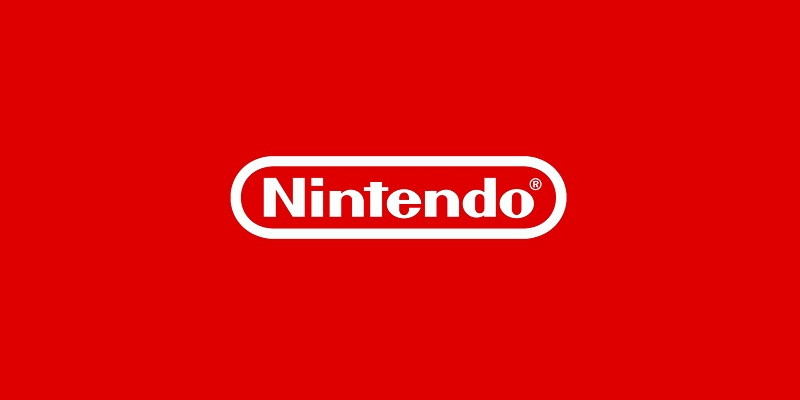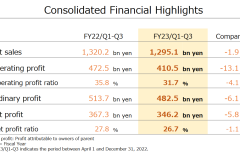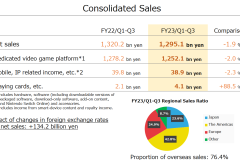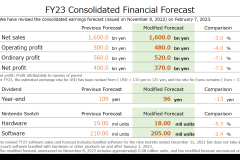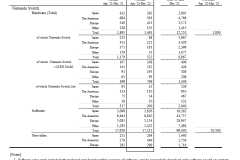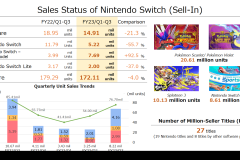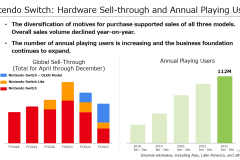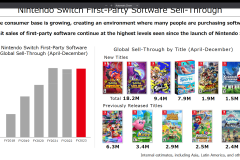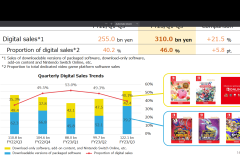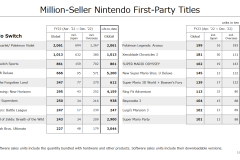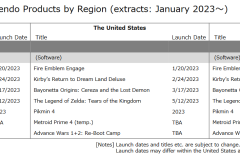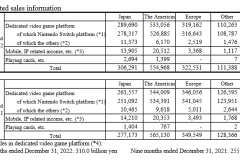Nintendo Financials (February 2023): results and highlights, Investors Briefing, Q&A
Nintendo Financials – Results
Nintendo have shared their latest financial results, covering the Nine Months Ended December 31st 2022 (April 1st 2022 to December 31st 2022). You will find all the details on these pages:
- Consolidated Financial Highlights, with consolidated operating results, the forecast for the current Fiscal Year, Nintendo comments, sales information (regional breakdown, digital sales), sales data and forecast, and more
- Financial Results Explanatory Material, with lots of additional sales data, list of million-sellers this Fiscal Year, release planning, and more
Some highlights:
- Pokémon Scarlet and Violet is off to a record-breaking start with 20.61 million units sold in two months
- Splatoon 3 sold 10.13 million units since launch, with 2.23 million units in Q4 2022
- Nintendo Switch sport sold 8.61 million units since launch, with 1.46 million units in Q4 2022
- Mario Kart 8 Deluxe sold 6.66 million units so far this Fiscal Year (with 3.59 million units in Q4 2022), bringing total sales to 52 million units
- Kirby and the Forgotten Land sold 3.47 million units so far this Fiscal Year (with 770 000 units in Q4 2022), bringing total sales to 6.12 million units
- In total, 27 games have sold over 1 million units during the current Fiscal Year
- Hardware: the Nintendo Switch has sold 14.91 million units so far this Fiscal Year. That’s a 21.3 drop year-on-year, mainly due to the shortage of semiconductors and other components that impacted production until late Summer.
- Software: 172.11 million units were sold so far this Fiscal Year. That’s a 4% drop Year-on-Year, partly due to the drop in Hardware sales.
- Digital sales: they reached 310 billion Yen, a 21.5% increase Year-on-Year due to strong sales of digital version of retail games and Nintendo Switch Online (which saw an increase in revenue).
Nintendo also revised their forecast for the current Fiscal Year downward for the second time in a row. They’re now expecting to sell 1 million Nintendo Switch consoles less than in their previous forecast (18 million units instead of 19 million units).
Also, the following pages have also been updated:
- Dedicated Video Game Sales Unit: Hardware and Software sales for Nintendo consoles
Top Selling Title Sales Units: Top 10 Software for each platforms:
- Nintendo Switch [Updated]
- Nintendo 3DS
- Wii U
- Nintendo DS
- Wii
Nintendo Financials – Briefing
The Investor Briefing is now available: click here to check it out!
Some highlights:
- during Q3, Hardware sales (sell-in, to retailers) was in line with expectations, but that wasn’t the case of sell-through (to consumers). The upswing in sales was lower than expected, especially compared to the previous year (which had the launch of the OLED model)
- by the holiday season, the effect of shortages of semiconductors and other components was largely resolved
- many consumers are buying the OLED Model as a replacement or as an additional unit
- sell-through for first-party games was at its highest level since the launch of the Nintendo Switch. Evergreen titles in particular saw steady sales, though they did not sell at the same pace as previous years
- digital sales accounted for 46% of total software sales
- during Q3 specifically, digital sales increased 10.2% to 122.1 billion Yen, a record for that quarter.
Nintendo Financials – Q&A
The official English translation of Q&A session with investors is now available: click here to check it out! Here’s the list of questions:
Question 1: Looking at Nintendo Switch software unit sales, I get the impression that although sales were firm in other regions, they have weakened in the Americas. Can you talk about the factors behind regional differences in the pace of software sales?
Question 2: Regarding hardware, you explained that sell-through [see note] during the holiday season fell short of expectations, but how did the demand for multiple systems fare during that period? Also, with Nintendo Switch entering its seventh year next fiscal year, do you expect a natural decline in unit sales?
Question 3: Considering the unit sales results for the current fiscal year, it seems like it will be difficult to stop the slowdown in hardware sales just by releasing new software. Are you planning any specific measures for next fiscal year?
Question 4: Looking at the sales of Pokémon Scarlet and Pokémon Violet and Splatoon 3, it seems that series with established popularity are accounting for a growing percentage of overall software sales. What are your thoughts regarding this situation? I would also like to hear how you plan to incorporate new titles that have the potential to expand the user base, similar to Ring Fit Adventure and Nintendo Switch Sports, as well as titles from other software publishers into the lineup.
Question 5: Going forward, what kind of life cycle do you expect for Nintendo Switch? If the hardware unit sales gradually decrease in the future, will software sales similarly decrease? Or do you expect software sales to stabilize at a certain level due to the increase in annual playing users? Please also talk about your pricing strategies for hardware and software going forward.
Question 6: Although sales of new titles are doing well, sales are not increasing for second and third titles. What plans do you have to raise sales going forward?
Question 7: The number of annual playing users has increased, but what about play time? Nintendo Switch will soon enter its seventh year, so we believe that a different strategy from before is required to invigorate the platform. Please tell us your thoughts from the perspective of how to increase play time.
Question 8: What are your thoughts regarding next fiscal year’s business results? You mentioned extending the Nintendo Switch life cycle by releasing software, but please tell us about any other initiatives, such as digitalization, that you are considering.

